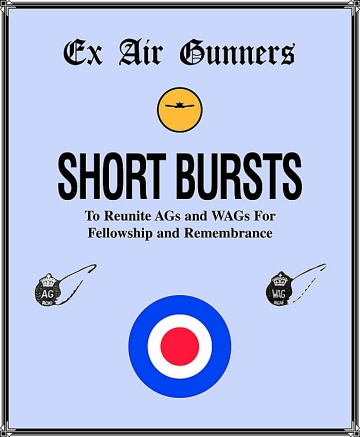
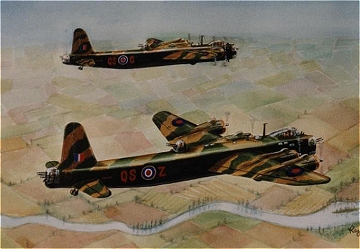
Stirling MK. 111
Range: 2330 miles
Bomb Load: 14000 lbs
Max. Speed: 250 mph
Ceiling 17000 ft
4 Bristol Hercules 14 Cylinder
Air Cooled Engines 1590 HP each
Total Stirlings to 1945: 2371


Stirling MK. 111
Range: 2330 miles
Bomb Load: 14000 lbs
Max. Speed: 250 mph
Ceiling 17000 ft
4 Bristol Hercules 14 Cylinder
Air Cooled Engines 1590 HP each
Total Stirlings to 1945: 2371
BRANCH NEWS N. Saskatchewan Branch
On Monday, March 19th. we held the regular monthly lunch meeting at the Lynx Wing on Ave. C North in Saskatoon.
It was nice to see the Andersen's back after wintering in the South.
We also had on hand Les Kell who participated in the Great Escape. Les was a tunnelor.
All those present were acquainted with what is expected of us to make "Short Bursts" on the Internet a success.In response to the March article on 419 Sqdrn. President Smokie Robson added the following:
Re 419 Sqdrn. - Its first mission was on January 11, 1942, to Brest.
Its last mission was on April 25, 1945, to Wangerooge.In total 4002 Sorties were completed.
The tonnage of bombs dropped was 13,417.
129 aircraft were lost.
1404 Aircrew were lost.- 310 killed
- 867 missing
- 187 POW
- 40 evadedEd. Thank you Smokie. We invite other Branches to give us a monthly report.
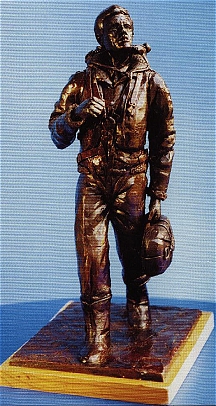 |
THE AIRCREW MEMORIAL ASSOCIATION The Aircrew Memorial Association was incorporated under the Societies Act of Nova Scotia, and as such, has been granted status as registered charity by Canada Customs and Revenue Agency. The primary mission of our Association is to erect a life size bronze statue of a WWII RCAF aircrew member (shown below) to honor the memory of Canadians who have served their Country as Aircrew of the Armed Services of Canada and it Allies. During WWII more than 25,000 RCAF Aircrew members proceeded overseas, approximately 17,000 of them gave their lives for the cause of freedom. Donations or requests for further information should be forwarded to:
Maj. (Ret'd) C.J. Dunbar,
|
SEARCH PATTERN The following, self explanatory letter, was received from Australia:
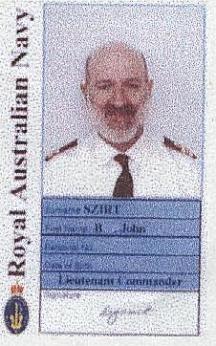
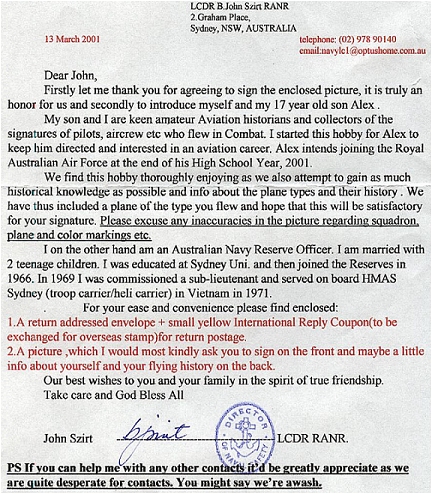
If you would like to help John and his son, Alex, share some of your experiences with them.
LANCASTER "J" JOHNNY 428 SQUADRON
by Bill ColeRear Gunner/Bomb Aimer
A memorable and musing night was July 25/26 1944. The target, Stuttgart, (ball bearings). Tenth Op. We arrived on the target without incident, but that was when all hell broke loose. The flak was the heaviest we had seen so far, even from the previous night on the same target. Both nights 10/10 clouds. It appeared that all guns were focused to form a solid curtain cross the target area and we had to fly through it no matter what. It was a really bumpy ride over the target and we were glad to get those bomb doors closed and to get to hell out of there. On leaving the target, the Navigator gave the Skipper the first leg home and we settled down for the return trip. After flying the first course for a period, the Nav. questioned the course the Skipper was flying. Something was up. The Nav. thought there was something amiss with their compasses and asked to have the Master Compass checked. The Wireless Air Gunner went back to check and announced that the rear end of the aircraft was a mess, including the Master Compass and some bulkheads had been redesigned just forward of the rear turret. On hearing this the Nav. maintained the course we were flying, and proceeded to shoot the stars to get our location. Thank God we were in clear skies. It turned out we were heading for the Atlantic across France instead of the Channel, so we turned right and headed North with the Nav. checking the stars periodically.
On this this trip I had, before leaving dispersal, picked up a 10 lb. practice bomb and smuggled it into my rear turret between my feet, with the idea of dropping it over the target. With all the excitement it slipped my mind, until we were half way to the Channel. At that time I figured it was time to get rid of it. I got up enough nerve to mention it to the bomb aimer, asking him if he would give me a target. Of course, the Skipper on hearing this, proceeded tear a strip off his indispensable Rear Gunner. (I'm sure that, if I could have been jettisoned, he would have pushed the button). The Skipper asked the Bomb Aimer to provide the target for me and that I had better hit the damn thing. So, a frustrated Rear Gunner, wishing to become the first Rear Bomb Aimer, sits and waits for the Front Guy to come up with a suitable target, which he does, as the sun's rays streak across the land of the hero "DeGaulle".
The target sighted I'm told to get ready. Reaching out into space, with the pin pulled, steady . . . steady . . . bomb gone! Wait for non-existent photo flash, peer out as puff of white smoke passes under, but no target! Oh, there it is, a shed, not an outhouse - damn it! I'm about a quarter mile short. The Front Guy is lousy and told him so. The Skipper says, "Ok, we've had our fun, lets settle down and get home and, by the way, you can forget about being a Rear Bomb Aimer."We finally got home, an hour late on fuel fumes, which made the CO happy - no letters to write. But the Ground Crew were peeved with what we had done to their beautiful baby.
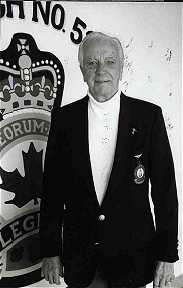
Bill Cole - before & after
A WORLD WAR II EXPERIENCE
by Andrew Haggins - Rear AG - 432 Sqdrn.On the evening of Sept. 22,1943, we took off on a 1000 bomber raid on Hanover, Germany. After bombing the target we headed home over the Freision Islands. As we flew out over the North Sea we discovered we were low in fuel and, about 60 miles from the English coast. We were forced to ditch about midnight. The North Sea, being so rough, we were unable to make a smooth ditching and, after hitting the water, I found myself trapped in the rear turret. Breaking the turret door open, I floated out of the turret just as the aircraft was going under. After I was out with my Mae West inflated, I discovered the dinghy had floated away and I could hear some of the crew in the dinghy. I had to swim for it which I figured was about 50 yards. After battling high waves I made it to the dinghy, finding only the Navigator and the Bomb Aimer had made it. We never saw the Pilot or Wop/AG.
We floated all night bailing out the dinghy and trying to keep warm. About 12 to 15 hours after ditching, we spotted a Wellington bomber in the distance. I fired three flares into the air and the Wimpy, turning towards us, flew down within 300 feet of our dinghy. It was a crew from our Squadron. The Wellington left and within two hours we spotted a British Rescue Launch coming towards us.The crew from the launch picked us out of the dinghy one by one with a rope around our waist. They pulled us aboard, gave us a good rub-down, a shot of navy rum, and we slept like logs. We arrived at port about 5 a.m. and were taken to a Naval Hospital where we spent 3 days.
Our CO W/C McKay sent his staff car to pick us up and take us to Eastmoore. After medicals and interrogation we were given 30 days leave. On our return from leave the Squadron was converting to Lancasters. My Bomb Aimer and I were crewed up with another crew and I was again designated to be the Tail-End-Charlie.
On the night of Nov. 16, 1943 we were on a cross-country trip at about 18,000 feet when the Flight Engineer reported engine trouble. Shortly thereafter the two Port engines caught fire. The Pilot came down to 2,000 feet and, after leveling out, the two Starboard engines burst into flames. The Pilot came over the intercom, "Abandon Aircraft". The Lancaster started to go into a slow spin. I opened the rear door and the Wop/AG, Mid Upper Gunner, and I, bailed out from under 1,000 feet.
I landed in a turnip field injuring my ankle The Mid Upper Gunner and myself spent the night in a near by hospital. The next morning we received word that the Navigtor had landed in a duck pond and had spent the night at a farm house. The Flight Engineer was found in a field, his chute had not opened.
The Lancaster had crashed killing the Pilot and Bomb Aimer. We returned to base the next day and, after a check up, were given 30 days survivors leave.After two narrow escapes, the Medical Officer referred me for a further medical in London, where they recommended that I be given 6 months rest from flying duties.
WELLINGTON CREW
Pilot Sgt. Ron Barlow RCAF K.I.A.
Navigator Sgt. Alex Buchan RCAF
Bomb Aimer Sgt. William Mayo RCAF
Wop/AG Sgt. Fred Reeson RAF K.I.A.
Rear AG Sgt. Andy Haggins RCAFLANCASTER CREW
Pilot Flt/Sgt. Ray Burgess RCAF K.I.A.
Navigator Flt/Sgt. Jim Bell RCAF K.I.A.
Bomb Aimer Flt/Sgt William Mayo RCAF K.I.A.
Flt. Engineer Sgt. K.C. Simmons RAF K.I.A.
Wop/AG Flt/Sgt. Jock Calderwell RAF
Mid. Upper AG Flt/Sgt. Paul Power RCAF K.I.A. (later)
Rear AG Flt/Sgt. Andy Haggins RCAF
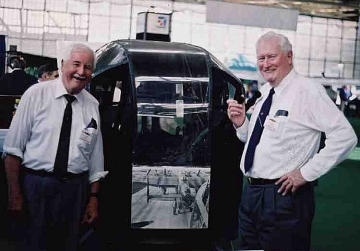
Bill Cockburn and Joe Davis man the FN Turret
at the Dowsview Air Show in Toronto
In the March Web Page there was an article on THE TOP SECRET TRUTH OF THE HALIFAX IV.
The following is the conclusion of the article on this facinating top secret steam powered Bomber.On many occasions the aircraft of S Squadron carried out raids into Western Europe, each without loss. The records up to mid 1944 do not show any German knowledge of the Halifax 1V, nor of any serious attempts at interception. The Royal Observer Corps based at Scarborough reported many times seeing high flying formations of B-17s, when, in fact, they were Halifax IV's on raids. Using their high speed, which was almost as fast as the FW190 and the Me109, and far superior height capability, the Halifax IV's roamed freely over enemy territory. Normally, they operated in daylight and good weather so to be sure to hit their target. Primarily, they attacked high value targets and, using their special bombsights, they scored success after success. On many occasions in 1943-45 they flew with the American 8th Air Force B-17s and B-24s on daylight raids deep into Germany. It was not uncommon for the Americans to mistake their twin vapour trails for P-38 Lightning escort fighters.
By mid 1944 the Germans had developed the means to counter the ever increasing numbers of Allied bombers escorted by fighters attacking in daylight. The introduction of the M163 (Rocket interceptor - 600 mph, 40,000 feet and armed with 2x3 cm cannon or eight unguided rockets) and, Me262 (Jet fighter - 540 mph, 36,000 feet and armed with 4x3 cm cannon) was intended to answer the daily destruction from the air of the German industry.
On Nov. 8, 1944, Sgt. Thomas' (Flight Engineer/Stoker) crew, along with their full Squadron were on a raid to Hamburg, Germany. Their task was to set the area ablaze in readiness for a 3 Grp. strike scheduled for later that night. Because of high cloud levels the Halifax IV's attacked from 36,000 feet. They were intercepted by four Me262 jets of the newly formed Nowotny Staffel. The jets, operating almost at their ceiling were nearly uncontrollable, and the Halifax IV's increased their altitude until out of range of the jets. The tail gunners of the twenty bombers poured .50 calibre machine gun fire down onto the German Jets and were pleased to see one of the Me262s disintegrate from the impact of the heavy shells. The unfortunate German Pilot was Staffel Commander, Major Walter Nowotny, an Ace. Enemy records show that Nowotny was brought down "by unidentified high flying aircraft." This was to be the first of two confirmed kills for the Halifax IV. The second came a month later, when another bomber was intercepted at 41,000 feet by an Me163 - once again the German rocket fighter was at its limit and short of fuel - its motor cut out. This left it a prime target and, in a bid to escape, the Pilot went into a steep dive, but the bomber followed, and with the speed building over 600 mph, the Pilot gave the Rear Gunner the opportunity to destroy the Me163 with his .50 calibres. After repeated strikes, the .50 calibre shells ignited Me163s fuel vapour and caused an enormous explosion. Witnesses on the ground observed the air duel and heard two massive booms that day, the first from the exploding Me163, and the second just as the British bomber pulled out of its dive. The Me163 did achieve a single hit with one of its 3 cm cannon, causing a large hole in the outer water tank. Had this been a conventional fuel tank there would have been a catastrophic explosion, fortunately however, the aircraft was able to make it back to base by periodically descending into cloud to restore its water supply.
The Halifax IV's ability to deliver a heavy bomb load and to defend itself against the best German fighters, while attacking heavily defended targets, made it one of the most remarkable of bombers ever to fly. As the German defences and industry were pulverized by the Allied bomber onslaught, the RAF developed harassing techniques to exhaust further the German moral by attacking several areas each night with small groups of aircraft. At night the Mosquito's attacked, while in the day the Halifax IV's continued to wreak havoc, giving the Enemy defences no rest at all.
Sgt. Thoms continued to fly with S Squadron and, to his knowledge, not one aircraft was lost on operations, nor were there any addition in numbers to the 20 Halifax IV's that they started with, such was the ability of the airframe. He recalls a few drawbacks. They had to get to the aircraft 2 hours before take-off to fire the boiler correctly, and the difficulty of shovelling coal inside a fuselage at 40,000 feet. But the pros were such that, as stoker, he could wear sorts and a vest, albeit with an oxygen mask, even at 40,000 feet. They always made it back and the boiler ashes were great for "baked spuds" The crew of a Halifax IV could also enjoy a hot meal (normally a sausage sandwich) on the return flight as, sausages wrapped in Window (tin foil), were roasted against the hot boiler. Harry recalls that during the summer months, while returning after a raid, they would descend to low level and jettison the hot ashes from the boiler onto German crops and forests to set them ablaze. - all part of the war effort. This left them vulnerable to attack but such was the confidence of Harry's Pilot in their amazing bomber that they could just out run all but the jets.
Today, Harry Thomas is a quiet Senior Citizen who enjoys reading and flying when he gets the opportunity. On the wall of his dining room is a photograph of 6 airmen sitting on the wing of a Halifax bomber with large inner engines - the famous Mark IV. Laughingly he recalls how, when starting the engines and idling the propellors, the two exhausts would make a chuff-chuff sound. Another trick, by venting high pressure steam, was to cause a whistling sound which they let go when taking off and buzzing the airfield on their return from a successful operation. He enjoys more than most the sight of a fully steamed up railway engine. And, as we sat in his dining room he pointed up to the sky as a jet left four four vapour trails, saying to me, "too many for a Halifax IV Lad"!
And now you have heard the rest of the story!
RETURN FIRE The Halifax IV article created some response:
Glen Clearwater says that when he read the article he was skeptical, but then he remembered a story he had heard shortly after the war.
"In 1945, I started work as a locomotive fireman with the CNR. During the first few years, I had to travel around to many different Terminals to find work as my Seniority Number was VERY low down the list. One day, while engaged in some R and R, in a local pub-The Pas, I think-a fellow Tallow pot, at the table, began to tell us about an experience he had. It had to do with what he claimed was a special squadron equipped with MK1V Halifax aircraft. They were driven by steam and he claimed to have been one of some 25 "stokers" aircrew who looked after the boiler room in the aircraft. There was one "stoker" per aircraft, one in each crew. Of course the rest of us, at the table, all thought that we were hearing a great line shoot but as it was his turn to buy we didn't want to discourage him.
He went on to tell us about how the firebox used coal for fuel. There had been some problems with getting rid of the ashes but this was solved, he said, by using a disposable ash container fastened beneath the firebox and resembling the housing of H2S antennae. The ash container was not to be dropped over enemy territory, as there was a fear that, if found, the enemy might be able to deduce the secret of the Hally MK IV.
When asked about how the coal was fed to the firebox, he was rather vague except to say that it was gravity fed from the top of the firebox and a belt driven by a small steam engine, which the "stoker" controlled, controlled the rate of feed. The supply of water to the boiler was also controlled by the "stoker" through the use of a feed water steam driven pump. There was a bit of a problem at the high altitudes that they operated at in both the supply of sufficient oxygen for proper combustion in the firebox and in keeping the boiler feed water at a suitable temperature before it entered the boiler, however he was not able to discuss these problems and their solutions in any detail as the whole thing was still on the secret list.
After a few more R and R, we were able to get him talking more about the Hally MKIV. When asked how the fire was started in the firebox, he explained how, on the ground-where else. In order to get sufficient draft through the grate area and get the fire going hot enough to begin boiling the water, a high-pressure air hose was attached to a special fitting that led to a nozzle below the smokestack. This blast of HP air up and out the smoke stack caused combustion air to be drawn through the firebox grates, through the fire bed, and the hot gases to pass through the boiler tubes, heating the water, and out the smoke stack. This was similar to the electric starting carts used to start some aircraft engines. After the boiler steam pressure reached a satisfactory level, the HP air hose was disconnected, and a steam valve was opened by the "stoker", this was called the blower valve. It allowed a strong jet of steam to enter a blast nozzle under the smokestack and did the same job as the HP air hose. Now the aircraft could be taxied. The blower valve had to be kept open until the aircraft reached sufficient flying speed
for combustion air to be ram-forced into the firebox through a damper controlled by the "stoker". When we asked how the crew could fly at such high altitudes, all he would say was that the crew compartments were pressurized and they could fly in comfort in shirt sleeves although the boiler room could get unbearably hot at times and the" stoker" had to strip down to his shorts.I would have liked to have heard more of his tale but when it became his turn to buy again, he left. I never saw him again and later I heard he had left the CNR and entered politics. Now I can't even remember his name."
An Air Force Chuckle submitted by Ted HackettA C-141-A Starlifter had been delayed for take-off for over an hour at Thule Air Force Base, Greenland, because its sewage container had not been pumped out. An Airman meandered up to the aircraft with the containment pump, fiddles around for a while and then gets ready to leave. The young Captain, who was the aircraft commander confronted the Airman, and stated, "You have caused me to be two hours late for my take-off. I'll see that you are not only reprimanded, but punished ass well!"
The young Airman smiled and said, "Sir, with all due respect, I have no stripes, I'm stationed at Thule, Greenland, its 20 degrees below zero, and I'm pumping shit from an aircraft. Just what kind of punishment did you have in mind?"
OBITUARIES 'JIMMY' V. BELL, #0495, NANIAMO, BC: Passed away Dec. 9, 2000. Served with the Merchant Navy after war broke out in 1939 on the North Atlantic run to Russia. Joined RAF in 1940 thinking the war would be over in six months. He transferred to the RCAF as R225879 taking AG training at the Isle of Man, also in Wiltsbury and Blackpool. Served with Nos. 31 and 62 Squadrons over Europe and Burma completing two tours of Ops earning the DFM. Following the war Jim returned to the Merchant Navy and obtained his Master Ticket for Deep Sea Vessels, eventually joining the BC Ferry Service and retiring as a Captain with 20 Years service.
RALPH G. BULLIVANT, #1030, SACRAMENTO, CA: Passed away Dec. 3, 2000. AG training at #8 Lethbridge and served with 196 and 432 Squadrons. Complete two tours, the second with Doug Penny as his Rear Gunner. Enjoyed his All-Canadian crew whom he said were well disciplined - and believed that was likely the reason they made it! Born and raised in Okotoks, AB he married a Californian girl and made that his home in 1947.
GORDON E. HUNT, #0181, CALGARY, AB: Passed away March 7, 2001. Enlisted RCAF Jan. '41 as a GD and shipped to the UK to serve with 404 Squadron at Dyce (Aberdeen) and Shetland Islands. Remustered to AG with training at Bishops Court in Northern Ireland. Posted to 103 Squadron at Elsham Wolds, Lincs where he completed 38 Ops. Screened and returned to Bishop's Court as Gunnery Officer before returning to Canada in March 1945.
JOHN LOUGHRAN, #0799, PENETANGUISHENE, ON: Joined RCAF and received Air Gunner training at #9 B/G. Overseas to serve with 625 Squadron. Following the war he served as Chairman of the Lion's Air Cadet 724 Squadron.
JOHN MacKENZIE, #0105, SARNIA, ON: Passed away June 11th, 2000. Joined the RCAF as R258815 in July '43. Manning Depot at Brandon, MB took AG training and graduated with his AG Brevet at #3 MacDonald B/G School. Posted to #98 Squadron with 2nd TAF completing a tour of 50 Ops and discharged in Winnipeg February 1945.
WILLIAM E. MARTIN, #0087, CALGARY, AB: Passed away Feb. 11, 2001. Enlisted July 1940, Manning Depot Toronto. Completed Wireless School at #2 in Calgary and graduated from #1 Mossbank B&G with his WAG Brevet. Overseas in April 1941 and eventually posted to #107 Squadron in Malta in Sept. '41 where he was seriously injured and burned in a Blenheim crash on Oct. 16/41. After a painful journey back to England he entered Queen Victoria Hospital at East Grinstead in May, 1942. Skin grafting and recovery led to Bill becoming a member of the Quinea Pig Club and he was serving as Chief Canadian Guinea Pig at the time of his passing. In recognition of Bill's wartime service he was awarded the Malta Cross. In addition to his membership in the Ex Air Gunner's Association he was also a member of the Air Crew Association.
GUSTAVE T. STULBERG, #0972, VULCAN, AB: Passed way Dec. 4th, 2000. Enlisted in the RCAF at Regina on 7 Nov. 1941. Attended #3 W/School in Winnipeg graduating with his WAG Brevet from #8 B/G Lethbridge in December '42. From Jan '43 to April '43 attended OTU on Hampdens at Pat Bay, BC. Posted to Bournemouth, UK June '43. Following conversion to DC3's at #105 OTU he and his crew ferried a Wellington a/c to Cairo, Egypt then to India arriving May of '44. Joined #61 RAF Squadron in Bengal dropping supplies to the army and evacuating wounded until Aug. '44. Joined SEAC Communications Squadron in Ceylon Oct. '44. Returned to the UK in Aug. '45 and repatriated to Canada in May 1946.
From Your Editor The Sterling picture in this Issue is a photo of a water-color painted by Member Ray Stoy. We will be featuring one of Rays paintings each month. If you would like to obtain one of Ray's paintings/prints, contact him at the following address. Ray will also do special orders, e.g. type of aircraft and markings as requested.Ray Stoy,
7728 U.S. Loop,
Bradenton, FL. 34202
USA Ph - (941)907-6077
Email - rpstoy@juno.comThank you Ray, for sharing your talent with us.
To make this Web Page a success we need material from Members so the Page can be up-dated each month. Lets give the chaps something to look forward to. Send pictures and copy to John Moyles - address and Email is on this page.
Until May, keep well. Cheers, John Moyles
|
Winnipeg
Northern Saskatchewan
Northern Alberta Branch
Southern Alberta
British Columbia Branch
send current information regarding regular meeting places, dates, and Contact Members, to John Moyles Box 6 Kenosee Lake SK S0C 2S0
Members are requested to send their experiences, articles, anecdotes, pictures, etc., to John Moyles and I will forward them to our Web Master in Brandon. Articles and Last Post items will be deleted from the page each month after the designated Member in each region has had an opportunity to copy the material for their Members. Notices of deceased Members are to be sent to Charlie Yule who is still our 'Keeper of the Rolls'. This is your SHORT BURSTS with no printing or mailing costs, and no deadlines! The Brandon Commonwealth Air Training Plan Museum has agreed to host our AG page. However, as it costs the Museum $35.00 per month to maintain the Web Page, it is suggested that each Ex-AG group contribute periodic donations to the Museum to help off-set this expense, and to enhance the work they are doing. We thank our Web Master, Bill Hillman, for his volunteer time and expertise. |
![]()
|
As You Were . . . Tribute Webzines |
Hillman WWII Tributes www.hillmanweb.com/war |
www.hillmanweb.com/rcaf RCN HMCS PRINCE ROBERT www.hillmanweb.com/rcn |
Ex-Air Gunners Association Magazines |
![]()
![]()
![]()
Webmaster:
William G. Hillman
BILL
& SUE-ON HILLMAN ECLECTIC STUDIO
Editor and Webmaster Bill Hillman
~ Copyright 1996-2021
© 2008 Bill Hillman and Ex-Air Gunners Association